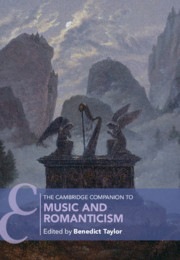Book contents
- The Cambridge Companion to Music and Romanticism
- Cambridge Companions to Music
- The Cambridge Companion to Music and Romanticism
- Copyright page
- Contents
- Figures
- Tables
- Musical Examples
- Contributors
- Preface
- Chronology
- Part I Horizons
- Part II Worlds
- 3 Music and Romantic Literature
- 4 Music, Romantic Landscape, and the Visual
- 5 Romanticism, the Folk, and Musical Nationalisms
- 6 Music, Romanticism, and Politics
- 7 Music and Technology
- 8 Music, Magic, and the Supernatural
- 9 A Kingdom Not of This World: Music, Religion, Art-Religion
- Part III Aesthetics
- Part IV Practices
- Part V Histories
- Select Bibliography
- Index
- References
4 - Music, Romantic Landscape, and the Visual
from Part II - Worlds
Published online by Cambridge University Press: 06 August 2021
- The Cambridge Companion to Music and Romanticism
- Cambridge Companions to Music
- The Cambridge Companion to Music and Romanticism
- Copyright page
- Contents
- Figures
- Tables
- Musical Examples
- Contributors
- Preface
- Chronology
- Part I Horizons
- Part II Worlds
- 3 Music and Romantic Literature
- 4 Music, Romantic Landscape, and the Visual
- 5 Romanticism, the Folk, and Musical Nationalisms
- 6 Music, Romanticism, and Politics
- 7 Music and Technology
- 8 Music, Magic, and the Supernatural
- 9 A Kingdom Not of This World: Music, Religion, Art-Religion
- Part III Aesthetics
- Part IV Practices
- Part V Histories
- Select Bibliography
- Index
- References
Summary
Using as a point of departure the paradigmatic example of musical landscape – Felix Mendelssohn’s overture The Hebrides (Fingal’s Cave), Op. 26 – this chapter considers how the idea of landscape came to shape the composition and subsequent reception of numerous Romantic works. In addition to addressing the question of why so much of this music has been heard to evoke a sense of place, attention is given to the very act of contemplating landscape, both by composers and by the protagonists that often occupy their works. Particular attention is given to Beethoven, Schumann, Liszt, and Mahler, but the expansive view of musical Romanticism offered here encompasses the proto-programmatic genre of the characteristic symphony, as well as the music of a diverse array of twentieth- and twenty-first-century composers from Charles Ives to Jonathan Harvey, composers whose engagement with Romantic landscape tropes reveal the continued relevance of this rich tradition.
Keywords
- Type
- Chapter
- Information
- The Cambridge Companion to Music and Romanticism , pp. 56 - 73Publisher: Cambridge University PressPrint publication year: 2021
References
Further Reading
- 1
- Cited by

